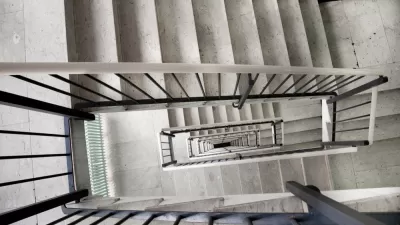One writer argues that single-staircase buildings solve an architectural problem and make buildings more interesting, but the political problem of the U.S. housing crisis goes much deeper.

The single-staircase building, prohibited in many U.S. cities due to fire safety regulations, has been getting a lot of attention lately as U.S. housing advocates look to loosening staircase regulations as one way to create more housing and lower construction costs. Planetizen has previously covered arguments in favor of single-staircase construction, whose proponents say it would improve housing affordability and encourage more ‘missing middle housing.’
Writing in The Nation, Kate Wagner argues that permitting single-staircase buildings is not the housing solution many think it is. Although a “good idea,” for Wagner, it is simply a design change that “fixes an architectural problem. There is little evidence as far as I can see that the schema will do anything to lower rents or fix urban inequality or anything else that would be so deeply transformative.”
Ultimately, for Wagner, the problem at the root of the housing crisis and of tragedies like the 2017 Grenfell Tower fire is “a housing market that is completely financialized and inherently predatory.” The drive to profit from housing as a commodity, Wagner argues, can’t be solved through design changes.
I would posit that rarely are buildings architectural failures—more often, they are social and political failures.
Wagner goes on, “Single-stair is not going to fix the housing crisis, because the housing crisis stems from an economic system in which housing is a commodity and a money-making scheme instead of a human right to shelter.” The key: “severing the connection between shelter and profit.”
FULL STORY: Single-Stair Layouts Are Not Going to Fix the Housing Crisis

Alabama: Trump Terminates Settlements for Black Communities Harmed By Raw Sewage
Trump deemed the landmark civil rights agreement “illegal DEI and environmental justice policy.”

Planetizen Federal Action Tracker
A weekly monitor of how Trump’s orders and actions are impacting planners and planning in America.

The 120 Year Old Tiny Home Villages That Sheltered San Francisco’s Earthquake Refugees
More than a century ago, San Francisco mobilized to house thousands of residents displaced by the 1906 earthquake. Could their strategy offer a model for the present?

San Francisco Opens Park on Former Great Highway
The Sunset Dunes park’s grand opening attracted both fans and detractors.

Oregon Legislature to Consider Transit Funding Laws
One proposal would increase the state’s payroll tax by .08% to fund transit agencies and expand service.

Housing Vouchers as a Key Piece of Houston’s Housing Strategy
The Houston Housing Authority supports 19,000 households through the housing voucher program.
Urban Design for Planners 1: Software Tools
This six-course series explores essential urban design concepts using open source software and equips planners with the tools they need to participate fully in the urban design process.
Planning for Universal Design
Learn the tools for implementing Universal Design in planning regulations.
Clanton & Associates, Inc.
Jessamine County Fiscal Court
Institute for Housing and Urban Development Studies (IHS)
City of Grandview
Harvard GSD Executive Education
Toledo-Lucas County Plan Commissions
Salt Lake City
NYU Wagner Graduate School of Public Service





























